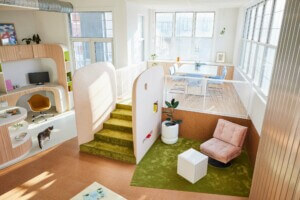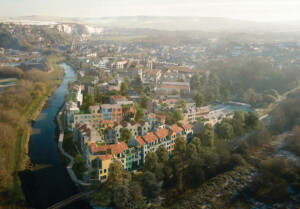With their winning design for the Association of Collegiate Schools of Architecture’s “Timber in the City” competition, three students from the University of Oregon have imagined wood’s viable potential in prefabricated low-cost housing. Wood construction has been a popular topic at AN recently and the topic of our recent feature, Timber Towers. Benjamin Bye, Alex Kenton, and Jason Rood entered the design competition last year with the mission to create a community of affordable housing and wood technology manufacturing in Red Hook, Brooklyn. Awarded first place, Grow Your Own City proposes the use of CLT (cross-laminated timber) for construction of nearly 183,000 square feet of mid-rise housing, a bike share and repair shop, and a wood distribution, manufacturing, and development plant.
The site itself was chosen as a residential and industrial area “in flux;” it is a waterfront neighborhood and competitors were required to balance these elements in a mutually beneficial way. Grow Your Own City designs a mixed-use community of wood production and housing construction, considering a variety of needs. Cost efficient and sustainable, the community is meant to manufacture its own wood, then use onsite development power and technology to build the final product: affordable modular housing units that can be prefabricated in the factory and fit together to form the mid-rise complex.
A “supersize plywood” technology that can be prefinished before construction, cross-laminated timber is stronger than regular wood construction and possesses a low carbon footprint. When forested correctly, wood can be a very sustainable and environmentally friendly building material. Most units include windows on two sides and vary in size from a 325 square feet studio to a 990 square feet three bedroom apartment.
Impressed with the students’ “mature sensitivity to zoning, politics, and concerns of gentrification” unique to this Red Hook site, the jury of architecture professors, green design architects, and a real estate venture praise the project for several specifics of design. A “green alley” allows for biking, timber education, and sustainable rainwater retention and reuse. And the CLT pods are attractive, livable, and realistic for a variety of occupants and their families.
“Overall, the project is strong because it maps out the terrain of the site while remaining consistent to the larger neighborhood in terms of plan, context and materiality,” the jury commented in a statement.










